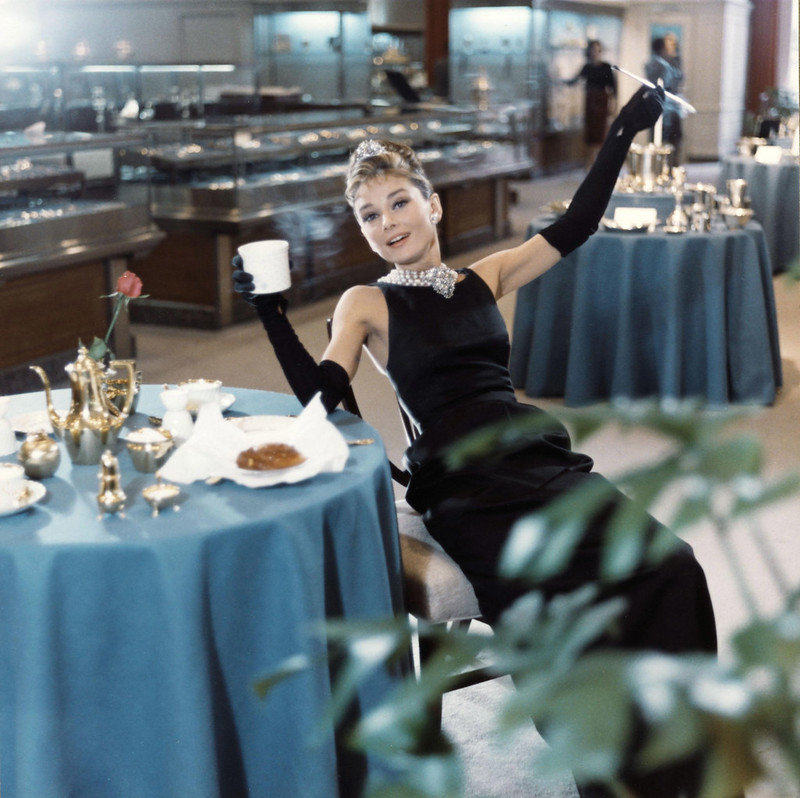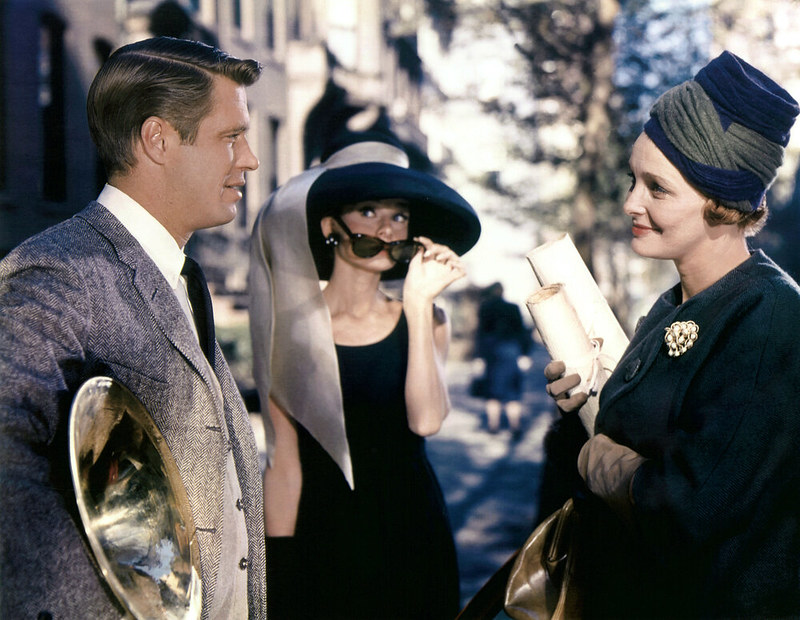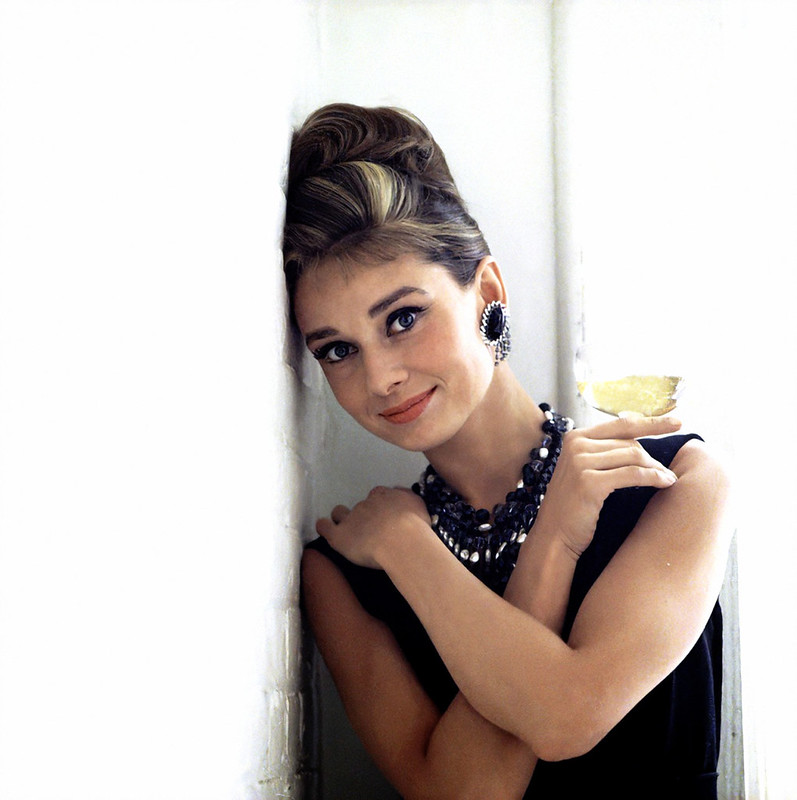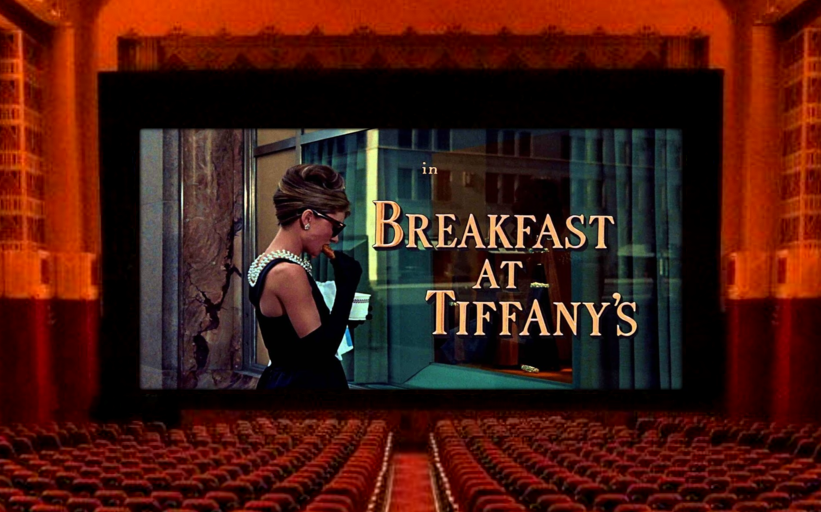WHAT: Breakfast at Tiffany’s (1961, 4K DCP)
WHEN: February 9, 2022 1 PM & 7:30 PM
WHERE: Pickwick Theatre, Park Ridge, IL
WHAT ELSE: Organist Jay Warren performs pre-show music at 7:00 PM! Cartoon: Dancing on the Moon (1935)
Plus: a Breakfast at Tiffany’s-themed prize basket! The first 50 ladies through the door at 6:30 PM (with a ticket) will be automatically entered to win! Included will be an item from Tiffany & Co. (The winner will be announced at 7:30 PM!)
HOW MUCH: $12/$10 advance or $10 for the 1 PM matinee
Advance Tickets for the 7:30 PM screening: Click Here!
Breakfast at Tiffany’s is one of those magical movies beloved by millions. There are so many moments from the film that come to mind, but perhaps none as poignant as the image of Audrey Hepburn sitting out on her fire escape, strumming a guitar and singing (in one octave) the haunting, Oscar-winning song “Moon River” (composed by Henry Mancini with lyrics by Johnny Mercer). The song was written especially for her.
Whenever the name Audrey Hepburn is mentioned these days, it is, more times than not, associated with Breakfast at Tiffany’s— Blake Edwards’ “rom-com” from 1961. “Holly Golightly” is arguably her most identifiable role with moviegoers– even with those who might not have seen the film. One instantly recalls Audrey in her simple, black dress, with the pearls and the beehive hairstyle– a tiara in the middle. Or it’s her oversized hat that fashionistas love, or her sunglasses, or that elongated cigarette holder seen in much of the film’s advertising. Audrey Hepburn was always a style icon, and this remains her signature film. Although trends come and go, Audrey has remained relatively popular in modern culture. Only recently, a biopic was announced with Rooney Mara cast to play Audrey.
But those who have actually seen Breakfast at Tiffany’s know it’s not all sugar, glitter and glam. The story is actually quite dark if one really stops to ponder it. George Axelrod’s screenplay was a loose adaptation of Truman Capote’s 1958 novella of the same name, which tells the story of a young girl lost in the big city. The screenplay toned down some of the narrative elements; Holly Golightly is actually a “cafe society girl” in the book– an “American geisha,” as Capote described her. The film skirts around the fact she’s a borderline call-girl living off gifts from men. The screenplay transformed Capote’s story into a movie about a woman’s free-spirited nature. Its themes were more attuned to the emerging “new woman” of the 1960s.
When I saw this film for the first time– at the Music Box Theatre in Chicago– I wasn’t sure exactly what Holly did with her life. The “$50 for the powder room” went over my head. Maybe I just couldn’t imagine the star of Roman Holiday being an escort. When the story was conceived, Truman Capote had Marilyn Monroe in mind, and he wanted Paramount to cast her.
Marilyn certainly would have been the more obvious choice for this type of part. However, her drama coach, Lee Strasberg, advised her against playing a call-girl, saying it would be bad for her image. She passed on it, as did Shirley MacLaine and Kim Novak. But according to producer Richard Shepherd, Audrey Hepburn was their first choice. She was offered the role, and Paramount was actually surprised she accepted it. At 31, she would be playing a character written to be 19. Capote felt betrayed with the studio casting. This would be a much different Holly Golightly– certainly more different than the one Marilyn Monroe would have played.
In fact, the whole film could’ve been much different. Director John Frankenheimer was involved with the project for several months, but when Audrey was signed, he was replaced by a better known director. Blake Edwards, whose Operation Petticoat (1959) — starring Tony Curtis and Cary Grant– had been his breakthrough film– was given the assignment. (Incidentally, Frankenheimer’s departure allowed him to start work on The Manchurian Candidate.)
Breakfast at Tiffany’s is more interesting with the atypical casting of Audrey Hepburn in the role. There were other actresses who could’ve played it, but few would have been as touching as Audrey in this film. She brought a sensitivity to the role and an emotional vulnerability, particularly in the scenes in which she talks about her brother Fred. That is more at the heart of what this character is all about.
The rest of the cast included George Peppard as writer Paul Varjak (“Fred, baby”); Patricia Neal as his benefactor– or “decorator,” as he tells Holly; Buddy Ebsen as Doc, (a figure from Golighty’s past); Martin Balsam as her Hollywood agent; Alan Reed as Sally Tomato; and in a small but memorable role, John McGiver as a Tiffany’s salesman–one of the comedic highlights of the film.
Blake Edwards was not particularly thrilled by the casting of George Peppard as Holly’s love interest who lives upstairs. In the film, he’s a “kept man.” Peppard, ever mindful of his movie star image, didn’t want to appear dominated by another woman (Patricia Neal’s “Emily”). This attitude led to some tension on the set between Peppard and the director. Throughout the film, his character is more an observer to Holly’s world. His best scene, though, comes near the end with the dialogue in the taxi cab. It was this scene, in fact, that sold Peppard on doing the film. But Paul Varjak is never quite as vulnerable as the version in the Capote story. The studio had insisted on Peppard because he was a rising star at the time. Blake Edwards, on the other hand, envisioned the character differently. The part had originally been offered to Steve McQueen, who was under contract at another studio.
Peppard, a student of Method acting whose best work would come in action films like The Blue Max and Operation Crossbow, admired Edwards as a director, but he reportedly made things difficult on set and tried to alter scenes that Edwards had carefully staged. Patricia Neal, who had worked with Peppard years before, found him unbearable at this time in his career. Audrey Hepburn, who got along with most everyone, found Peppard cool and pompous– at least, according to a more recent news story. However, it’s also been reported that they remained friends until her death in 1993. Peppard would pass away the following year.
The biggest issue with the film’s cast wasn’t George Peppard, however. The most problematic aspect of the film remains Mickey Rooney as Golightly’s upstairs neighbor, Mr. Yunioshi. Rooney, a white actor, portrays an outrageous caricature of a Japanese man. Rooney was never the most subtle actor to begin with, particularly when it came to comedy, and he plays the role broadly. In 1961, audiences at the time were not outraged by what they saw with this performance– there were no protests at that time. Most moviegoers recognized it for what it was– a caricature–funny only in the sense of how bad it was.
In retrospect, particularly now in our more sensitive times, the role is pretty egregious and just plain unfunny. Every time Mickey Rooney appears, it takes the audience right out of the film. The character really serves no essential purpose and doesn’t fit with the tone of the film. Edwards had insisted on Rooney’s casting (instead of using a Japanese actor to play Yunioshi), so the fault lies with him. In later years, Edwards regretted this decision and admitted he should have re-cast the part.
Blake Edwards was a hit or miss director (with most of those misses coming towards the end of his career). For most fans, his best work will always be the films he made with Peter Sellers. In the early 1960s, Edwards was at the top of his game, and Breakfast at Tiffany’s remains one of his most enduring films. It’s remembered for its romance and for one of the most famous (and wet) final clinches in movie history.
And it’s a genuinely funny comedy (if you overlook Mickey Rooney). As a director of comedy, Edwards seemed to excel when he was staging parties, and Breakfast at Tiffany’s offers one of his best; the sequence in Holly’s apartment features many visual gags that were not written in the original story. (Fans might also appreciate 1968’s The Party with Peter Sellers.)
Breakfast at Tiffany’s was nominated for five Academy Awards– winning two (Best Music Score and Best Original Song). Despite its blemish (which has become more glaring in the decades after its release), the film endures. Perhaps one day someone will attempt to remake it or “improve” it for modern sensibilities– just look at the recent West Side Story (which, it’s worth noting, failed at the box office). In both cases, it’s the original from 1961 that fans embrace. There may be other Holly Golightlys in the future, but there will never be another Audrey Hepburn. Her value to this film is as priceless as the jewelry on display in the window at Tiffany’s.
The year 2022 is the centennial of Blake Edwards’ birth (July 26, 1922), so our screening will be an apropos way to mark the occasion– as well as to celebrate Valentine’s Day.
~MCH





